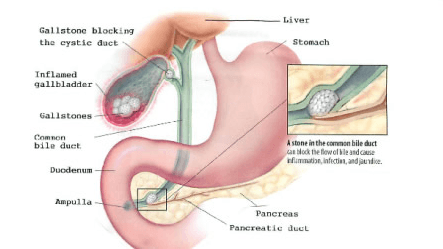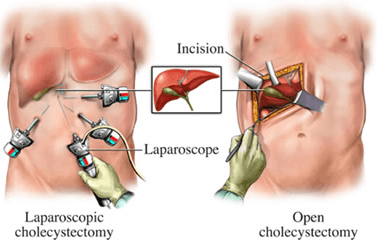The Gallbladder, What It Does, and Surgery
Most people pay no attention to their gallbladder until there is a problem. The gallbladder serves an important purpose, but when it becomes diseased or inflamed, quite often the best course of action is gallbladder removal surgery.
The gallbladder, part of the biliary system, is a teardrop-shaped organ located in the abdomen. The gallbladder collects and concentrates bile, a liquid composed of water, cholesterol, lecithin, bilirubin, and bile salts, that is produced by the liver. The body uses bile to eliminate waste from the body and also to break down fats during digestion. After food passes through the stomach, bile is released from the gallbladder, through the common bile duct into the small intestine, where it begins breaking down fats.
If you feel that you’re experiencing any of these symptoms, severe pain, or have been told you have gallbladder issues, contact top Dallas TX gallbladder surgeon Preeti Malladi today.
Gallbladder Conditions
Gallstones
If there is too much cholesterol, bilirubin and/or bile salts in the bile, gallstones may develop. Stones comprised of cholesterol and bilirubin are known as cholesterol stones. Those made mostly of bile salts are called pigment stones. Gallstones may not cause any problems, or they may lodge in the bile ducts and block the flow of bile. There may be no symptoms, or if a stone is lodged in a duct, it can be extremely painful and can cause an array of unpleasant symptoms.
Cholecystitis
When gallstones block the ducts and bile becomes trapped in the gallbladder, the organ becomes inflated and painful. This condition is known as cholecystitis.
Acalculous Cholecystitis
The gallbladder can become inflamed even when there are no stones present. Acalculous Cholecystitis may be caused by severe illness, prolonged fasting, or several other reasons.
Chronic Gallbladder Disease
Recurrent blocked ducts and chronic inflammation in the gallbladder can lead to infection, swelling, and permanent damage of the gallbladder. When this occurs, scarring inside the organ means it can no longer function properly. Symptoms of a dysfunctional gallbladder include abdominal fullness, increased gas, indigestion and diarrhea.
Perforated Gallbladder
Untreated gallbladder disease, gallstones or severe acute cholecystitis can cause a perforation in the wall of the gallbladder, causing leakage of infection into the peritoneum.

Risk factors
There are various risk factors that may result in the development of gallstones and their associated conditions, including:
- Obesity
- Rapid weight loss which increases fat metabolism of the body and causes excess cholesterol secretion by the liver.
- Prolonged fasting which may produce an over concentration of the bile with cholesterol to produce gallstones.
- Elevated estrogen production tends to increase cholesterol. This happens during pregnancy, during hormone replacement therapy or while taking oral birth control.
- Gender – Women are more prone to gallstones formation than men
- Ethnicity – Native Americans have genetically influenced higher levels of cholesterol in bile and so have a higher risk of gallstones
- Intake of cholesterol-lowering drugs and low caffeine increases risk of gallstones.
- Sedentary lifestyle. Low levels of physical activity are associated with increased risk of gallstones.
In addition, people with high triglyceride levels and conditions such as anemia, sickle-cell disease, thalassemia, hereditary spherocytosis, elliptocytosis, or jaundice, are at high risk of developing gallstones.
Symptoms
While gallstones and other gallbladder conditions often cause no symptoms, when they do, they symptoms usually appear suddenly. This sudden appearance of symptoms is often referred to as a “gallbladder attack”. Symptoms may include:
- Severe abdominal pain
- Back pain near shoulder blades
- Nausea and vomiting
- Abdominal bloating and belching
- Intestinal colic
- Stomach upset
Diagnosis
Gallstones and cholecystitis are often diagnosed through ultrasound imaging. Other advanced techniques or tests that may be used to diagnose this condition include:
- Endoscopic ultrasonography
- Cholescintigraphy (HIDA) scan
- CT scan
- Endoscopic retrograde cholangiopancreatography (ERCP)
- Laparoscopic common bile duct exploration
Gallbladder Disease Treatment, Treating Gallstones & Other Conditions
Gallbladder surgery is considered the standard of care to treat gallstones and most other gallbladder conditions. You likely know several people now who are living a normal life without their gallbladder. Once the diseased gallbladder is removed, the bile that it once stored is instead passed directly from the liver into the small intestines through ducts.
Cholecystectomy is the term for gallbladder removal surgery, which is usually a laparoscopic procedure. This means it is done with minimally invasive techniques as opposed to open abdominal surgery which requires a long incision. During laparoscopic cholecystectomy, small abdominal incisions are used to insert surgical instruments and a laparoscope, an instrument with a light source and a camera on the end. The laparoscope allows the physician to see the gallbladder and the tiny instruments are used to surgically remove the gallbladder. If you’re looking for a gallbladder surgeon in Dallas, Plano, or in the North Texas area then contact Dr. Preeti Malladi today.

Procedures on the gallbladder may require an overnight stay in the hospital, or it may be performed as an outpatient procedure. While this non invasive procedure to remove the gallbladder is performed frequently by gallbladder surgeons with minimal complications and is a less invasive approach, no surgical procedure is without risk of possible complications. The most common complication of gallbladder surgery is injury to the bile ducts. In the unlikely event this occurs, there can be leakage of bile inside the body. This leakage may cause pain and infection.
In cases where gallstones are present inside the bile ducts, the endoscopic retrograde cholangiopancreatography (ERCP) technique may be used. During ERCP an endoscope (a long, flexible tube, with a light source) is used. The endoscope is inserted through the patient’s mouth and is connected to a viewing monitor. The endoscope goes through the stomach to the small intestine and then locates the blocked duct by releasing a special dye. The affected duct can be cut with tiny instruments on the endoscope. The endoscope then captures the gallstones and they are removed when the endoscope is removed.
In some cases, when the gallstones are small and are not calcified, medications may be used to break them up. Lithotripsy (the use of shock waves), which is the common procedure used to destroy kidney stones, may be used to treat gallstones in some instances.
Preventive measures (Diet)
Eating a low-fat, high-fiber diet may reduce the frequency and severity of gallstone symptoms and gallbladder problems.
